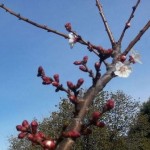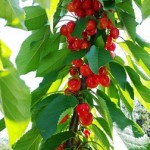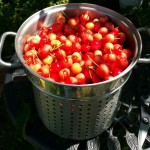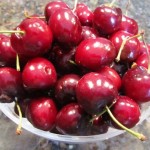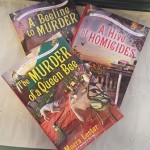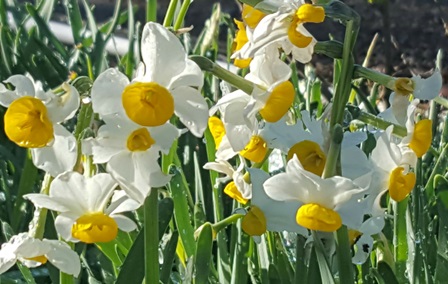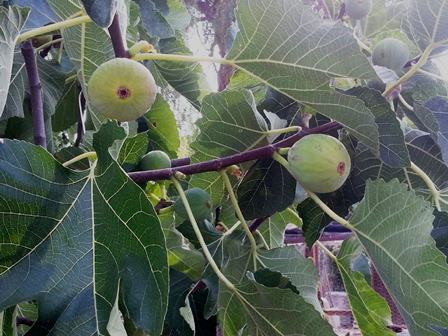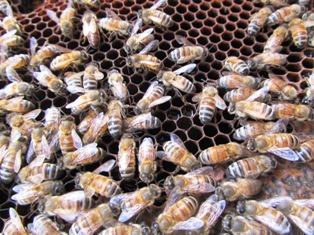Growing a Bountiful Crop of Sweet Cherries
Cherries are perfectly suited for growing well in our northern California climate. About ten years ago, we planted several sweet cherry trees–Bing, Stella, and Black Tartarian. They’ve proven to be easy trees to grow and reward us with bountiful crops of sweet, ripe cherries around Memorial Day each year.
If you want to grow some sweet cherries, you’ll need to space for a tree or two. Sour cherries will self pollinate but sweet cherries need a pollinator and that means you’ll need to plant two trees 30 to 40 feet apart unless you are growing a dwarf variety. Dwarf trees should be spaced 5 to 10 feet apart. The trees need sun, good air circulation, and well-drained fertile soil. Drainage is important because cherry trees are susceptible to root rot.
Once the trees are established, prune in early spring to remove large limbs or those that are broken, damaged, or too weak to produce fruit. In late summer, a second pruning can be done (this one less aggressive) to open up the canopy and improve air circulation.
A newly planted cherry tree can take three to five years to produce fruit. But you’ll be rewarded when your full-size tree produces 40 to 50 quarts of ripe fruit. In Northern California, cherries ripen from early June to late July.
You’ll be sharing your ripe cherries with the birds unless you use netting over your tree. A bird will peck a single hole in a perfect cherry and then move on, leaving the damaged cherry to rot on the tree. Local wildlife such as opossums and raccoons also enjoy feasting on cherries, climbing the trees to reach the fruit.
Cherries must be picked at the peak of perfection for if they are picked too soon, the fruit will not slowly ripen in your kitchen. Cherries are more perishable than blueberries, so wash and eat them soon after picking. A pit remover makes it easy to remove the stone from the center of the fruit.
Some people prefer sour cherries for making pies and jam and sweet cherries for eating fresh. Preserve cherries after removing the pits by canning in a hot water canner, drying them using a dehydrator, or freezing them.
______________________________________________________________________________
If you enjoy reading about our adventures in country living, check out my Henny Penny Farmette series of cozy mysteries. They’re chocked full of delicious recipes, gardening tips, and insights into keeping chickens and honeybees. Or, learn about how to take better care of yourself with my health, wellness, and spirituality books. All are available online and wherever books are sold.
Critter-proofing Your Bulbs
I planted bagfuls of tulips, daffodils, crocus, and grape hyacinths over the last two years in the autumn. The daffodils are blooming now and the other bulbs in my garden have plenty of foliage.
Because voles, moles, gophers, squirrels, raccoons, and other critters will dig and eat the bulbs and deer will devour the blooms at first blush of color, a savvy gardener must figure out how to protect these beautiful flowers.
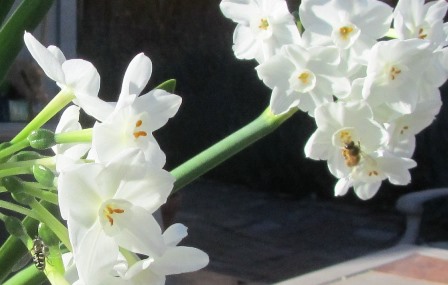
The bees are drawn to the sweet scent of narcissus that have now naturalized in my Henny Penny Farmette gardens
Throughout the Midwest of my youth, hillsides, front yards, and cemeteries were always places where daffodils grew in perfusion. Along with the arrival of robins and other songbirds, these flowering bulbs herald the coming light and warmth of spring. I’ve lost plenty of these plantings myself so have some tips to help you prevent such a loss.
Seven ways to protect flowering bulbs.
1. Grow them behind a double fence barrier. Deer can jump high and might go over one fence, but not a second one built near the first.
2. Use mesh to deter moles, voles, gophers, groundhogs, and other digging critters.
3. Erect fences that are at least three feet tall and with at least a foot buried beneath the earth.
4. Plant in raised beds covered with mesh. The bulbs will be protected while the foliage and blooms poke through toward the light.
5. Clean up the area in the fall after planting the bulbs. That way, critters won’t be attracted to your bulb beds.
6. Consider using deer-repellent sprays on tulips and growing deer-resistant bulbs.
7. Use ammonia-soaked rags in coffee cans or old planting buckets around the garden to repel pests with a keen sense of smell such as rabbits and opossums.
* * *
Enjoy reading about farming topics? Check out my cozy mysteries–A BEELINE TO MURDER and also THE MURDER OF A QUEEN BEE (both in the Henny Penny Farmette series from Kensington Publishing). Kobo Books has A BEELINE TO MURDER on sale. Check out this incredible deal on https://www.kobo.com/us/en/search?Query=Meera+Lester
My farmette and bee-based novels are chocked full of recipes, farming tips, chicken and beekeeping tips, sayings and, of course, a charming cozy mystery. For more info, click on the links under the pictures.
The books are available through online retailers such as Amazon, Barnes & Noble, Target, BAM, Kobo Books, and Walmart as well as from traditional bookstores everywhere.
See, http://tinyurl.com/hxy3s8q
A Beeline to Murder is the debut novel that launched the Henny Penny Farmette series of mysteries. Initially released as a hardcover novel and in e-book format, it is now available as a mass market paperback.
See, http://tinyurl.com/h4kou4g
NEWLY RELEASED! This, the second cozy mystery in the Henny Penny Farmette series, is garnering great reviews from readers and industry publications.
A Sprained Leg Can Spell the End for a Chicken
Foxes have been routinely prowling my property and have claimed two chickens from my neighbor over the last few weeks. Thank goodness, they weren’t my hens. That said, one of my White Leghorns, a breed that originated in Tuscany but is widely raised here, developed a sprained leg, making her extra vulnerable to predators.
I noticed she was having trouble standing a few days ago. Then yesterday, I found her cowering under the hen house steps because the flock had been attacking her. I immediately removed her and tried to find a solution that would allow her time to heal without simultaneously having to find off foes.
My poultry run has its fencing wire buried into the ground and pieces wired together over the top. It’s built that way to prevent entry by raccoons, coyotes, and foxes that dig as well as hawks that hunt from the sky. But what to do with a flock of chickens that will peck to death another hen that get sick or injured?
Yesterday, inside the secure run, I built an inner circular area using poultry wire. Locating a large cardboard box, I filled it with nesting straw and stapled part of an old sheet as a curtain over the doorway. Then I put heavy blankets on the box for warmth (it’s been getting cold at night). I put a water dispenser and food outside her box and hoped for the best.
When I checked on the hen this morning, she was standing upright on both legs. She explored the inner run and then hopped back into the box to wait perhaps for the sun to warm the run. As quickly as she is healing, I might be able to integrate her back into the flock in a few days or a week.
The rains are coming tomorrow–another threat for the poor creature–so I’ll have to figure out another option to keep her dry and warm and safe. Still, she seems to be on the road to recovery and I hope returning to her scratching and foraging soon because she has stopped laying during this traumatic period. And she was one of my best egg layers; she’d lay an extra-large egg almost every other day. See, https://en.wikipedia.org/wiki/Leghorn_chicken
* * *
If you enjoy reading about farm topics (including gardening, beekeeping, and delicious recipes), check out my cozy mysteries A BEELINE TO MURDER and also THE MURDER OF A QUEEN BEE in the Henny Penny Farmette series (from Kensington Publishing).
These novels are available through online retailers such as Amazon, Barnes & Noble, Kobo Books, and Walmart as well as from traditional bookstores everywhere.
Find more info or to order, see, http://tinyurl.com/hxy3s8q
Now available in mass market paperback, this debut novel launched the Henny Penny Farmette series of mysteries and sold out its first press run.
See, http://tinyurl.com/h4kou4g
The Murder of a Queen Bee is the newest offering in the Henny Penny Farmette series. For more information, click on the link under the image.
What’s Not to Love about Edible Figs?
Many backyard gardeners start checking their fig trees this time of year for ripe fruit. Most figs grown for their fruit bear two crops a year (spring and fall). When figs are ripe, the globular fruit becomes soft and hangs downward from the branch. This fruit will not ripen on the windowsill or in a paper bag, so picking fruit while it is still firm is not advised.
I grow White Genoa, Adriatic, and Brown Turkey figs on my farmette. One of my nearest neighbors grows the Mission fig, which is a very large tree taking up most of his backyard. This time of year, his tree is heavily laden with purple-black fruit. Throughout the fall, that Mission fig tree is frequently visited by the birds, squirrels, and raccoons that eat the fruit.
Cooks appreciate the versatility of figs for cooking. There are many ways to prepare them. Grilled figs are delicious when served on a crostini with a dollop of goat cheese and drizzled with honey. The pulp can be used to make fig bars and other types of cookies. Luscious, juicy figs may be made into chutney or jam, baked in cakes, paired with almonds in a tart, sliced into salads, grilled with lamb, or served simply with port.
Fig trees are easy to grow, too. They need full sun and good drainage; many cultivars are drought tolerant. Lightly prune as necessary in winter. Enjoy.
* * *
If you enjoy reading about farmette topics (including gardening, beekeeping, and delicious recipes), check out my cozy mysteries A BEELINE TO MURDER and also THE MURDER OF A QUEEN BEE in the Henny Penny Farmette series (from Kensington Publishing).
These novels are available through online retailers such as Amazon, Barnes & Noble, Kobo Books, and Walmart as well as from traditional bookstores everywhere.
See, http://tinyurl.com/hxy3s8q
Now available in mass market paperback, this debut novel launched the Henny Penny Farmette series of mysteries and sold out its first press run.
See, http://tinyurl.com/h4kou4g
The second cozy mystery in the Henny Penny Farmette series, available Sept. 27, 2016, is now available on Net Galley (netgalley.com) for professionals and readers who write reviews.
Growing and Sharing Farmette Figs
It’s that time of year when our fig trees reward us with a second crop of sweet, juicy fruit, best eaten right from the tree.
We aren’t the only ones who love to eat figs. The birds and raccoons are leaving telltale marks that they’re helping us devour this sweet fruit. And it’s no wonder.
Figs are a nutrient-rich food with antioxidant properties. They contain magnesium, vitamin B6, fiber, and beneficial amounts of calcium and iron.
We grow a couple of varieties of figs on the farmette–a White Genoa and Brown Turkey. Our neighbors also have towering fig tree with a canopy that reaches over the neighbor’s house. The tree is loaded now with baseball-size, dark purple fruit. I believe it’s a Black Mission fig, introduced into California by Father Junipero Serra who planted them in 1769 at the San Diego mission.
Our Brown Turkey fig produces a crop twice each year. The first crop, known as the breba grows on last season’s wood. The second, and more abundant crop, grows on new wood.The fig has rose-colored flesh inside a brownish-purple skin that tends to crack open with the fig is overripe.
The White Genoa is self-fruitful and has yellow-green skin with strawberry-colored pulp. The taste is mild and sweet and can be enjoyed as fresh fruit or paired with tangy goat cheese. The tree bears two crops each year and benefits from a vigorous pruning in the autumn after the figs are harvested.
Both figs will lose their leaves, leaving only their bark color and scaffolding as winter interest in the garden. The White Genoa’s bark is light gray whereas the Brown Turkey has a darker shade of grayish-brown bark.
These trees can be grown in containers and kept to about six feet tall for people who don’t have a lot of space for a tree that can otherwise reach 15 to 20 feet.
Figs aren’t fussy about soil, but won’t tolerate excessive water. They like the sun and are pretty hardy here in Northern California. Many figs are self-fruitful, but keeping bees means I have pollinators to help the fig crops along.
Skunks Snacking on Bees, Who Knew?
I had to do some searching around the Internet to beekeeping sites to find out whether or not skunks eat bees. Apparently they do.
The way it works, a skunk comes around in the early evening after sundown and will scratch on a hive until the guard bee or bees come straight out and then swats at them before eating the bees. Mother skunks even teach this behavior to their young.
My beekeeper neighbor keeps his hives elevated onto a bottom board platform. One would think this should ensure that the skunks would not bother the hive, but there is evidence lately of a skunk coming around.
Some of the telltale signs that a skunk might be raiding your hives are scratch marks on the hive, muddy prints if there’s a water source nearby, skunk feces (some may have dead bees in it), and dead bees on the ground in front of the hive.
When marauding mammals like skunks and raccoons get a taste for bees, a hive can die. Some suggestions I found searching around on the Internet include putting down tack strips (like those used to install wall-to-wall carpets).
Another is to put a screen around the hives (with an opening at the top for the bees to come and go) or place chicken wire in front of the hives. Skunks like standing on solid footing, not wire or mesh. A roll of mesh at the base of the hive could also be an effective deterrent.
You definitely want to get rid of the skunks. One can decimate a hive in a single night scratching, eating, throwing dirt until the bees get angry and come out in mass and then the skunk has a big meal. The hive thus weakened can be empty within a day or so.
 Facebook
Facebook Goodreads
Goodreads LinkedIn
LinkedIn Meera Lester
Meera Lester Twitter
Twitter



